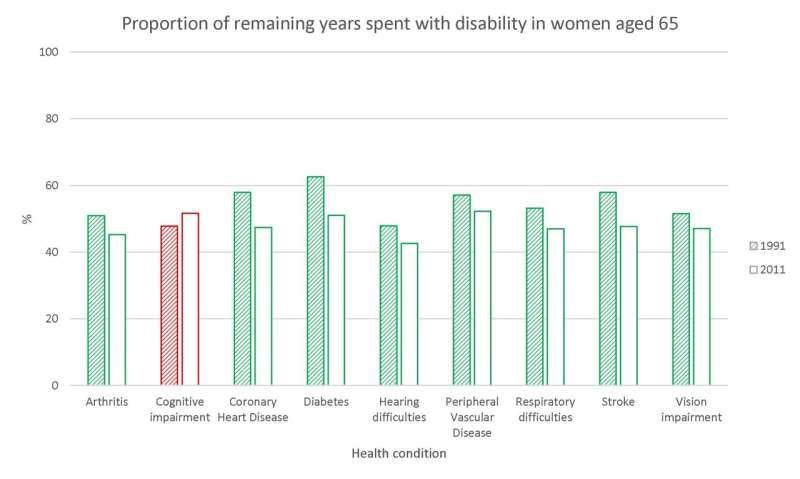
The number of healthy years a person lives is, on average, increasing even for people with common chronic conditions, according to a new study publishing March 15 in PLOS Medicine by Holly Bennett of Newcastle University, UK, and colleagues.
Over recent decades, there have been advances in healthcare that mean many people with chronic health conditions are living longer. In the new study, researchers wanted to determine whether this extension to life involves an increase in years with or without disability. The team analyzed data from two large population-based studies of people aged 65 or over in England. The studies, the Cognitive Function and Aging Studies (CFAS I and II) involved baseline interviews with 7,635 people in 1991-1993 and with 7,762 people in 2008-2011, with two years of follow-up in each case.
For both healthy people and those with health conditions, the average years of disability-free life expectancy (DFLE) increased from 1991 to 2011. Overall, men gained 4.6 years in life expectancy (95% CI: 3.7-5.5 years, p<0.001) and 3.7 years in DFLE (95% CI: 2.7-4.8, p<0.001). Men with conditions including arthritis, coronary heart disease, stroke and diabetes gained more years in DFLE than years with disability. The greatest improvements in DFLE in men were seen for those with respiratory difficulties and those living post-stroke.
Between 1991 and 2011, women experienced an increase in life expectancy at age 65 years of 2.1 years (95% CI: 1.1-3.0 years, p<0.001), and an increase in DFLE of 2.0 years (95% CI: 1.0-2.9 years, p<0.001). Similar to men, most improvement in life expectancy for women with long-term conditions was in disability-free years. However, women with cognitive impairment experienced an increase in life expectancy with disability (1.6 years, 95% CI: 0.1-3.1, p=0.04) without any improvement in DFLE. Men with cognitive impairment experienced only a small increase in DFLE (1.4 years, 95% CI: -0.7-3.4, p=0.18) with an increase in life expectancy with disability that was comparable in magnitude (1.4 years, 95%CI: 0.2-2.5, p=0.02). Therefore, at age 65, the percentage of remaining years of life that were spent disability-free decreased for men with cognitive impairment (difference CFAS II-CFAS I: -3.6%, 95% confidence interval (CI): -8.2-1.0, p=0.12) and women with cognitive impairment (difference CFAS II-CFAS I: -3.9%, 95% CI: -7.6-0.0, p=0.04).
Source: Read Full Article





